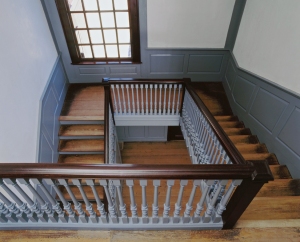It makes a great scene, doesn’t it? In the dead of night, a thief breaks quietly into the house. Sneaking up the stairs, he comes down hard on one foot when one of the stair risers is unexpectedly shorter than the rest. Thud! The noise wakes the household and the thief is caught!
Many historic houses have uneven risers in their staircases. The myth of the burglar alarm staircase has been related by docents throughout the country, including . . . I blush to disclose . . . me. Well, geez, I heard it from one of the older tour guides back in the late ’70s and it sounded believable to someone young and inexperienced . . .
The scene of my crime was the back staircase in the 1718 portion of Williamsburg’s Peyton Randolph House house. The staircase has seventeen steps, with the top riser significantly shorter than the rest. A lot of old houses have similarly uneven risers. If this is a myth–and it is–what explains the uneven risers?
Garland Wood, Colonial Williamsburg’s master carpenter, says it better than I; “Building stairs is hard! It’s not natural or intuitive. Nineteenth- and twentieth-century stair building books [yes, people wrote entire books about how to build a staircase] show mathematically precise ways to use modern framing square to lay out the stringers and make the cutouts for the treads and risers. Stairs were laid out so precisely that some were build in workshops offsite and then brought in and installed. But that’s not the way stairs were built in Williamsburg in the colonial era. Most stairs in the Historic Area were built from the bottom up, one riser and tread at a time. Invariably, error creeps in as more treads are installed which leads to the final riser being a little tall or short. What is the carpenter supposed to do? Tear it all down and start over, or simply leave the last set of treads and risers a little out of whack?”
Without the mathematical aides, modern framing squares, and stair building treatises of later years, it took an unusually skilled (or lucky) carpenter to build a stair onsite that comes out perfectly. The average carpenter could build a stair that got you up and down, but not with perfectly aligned treads and risers. Uneven risers could also have been caused by inferior workmanship during subsequent repairs, or by the house settling over time. They were never intentional.




 Posted by Mary Miley
Posted by Mary Miley